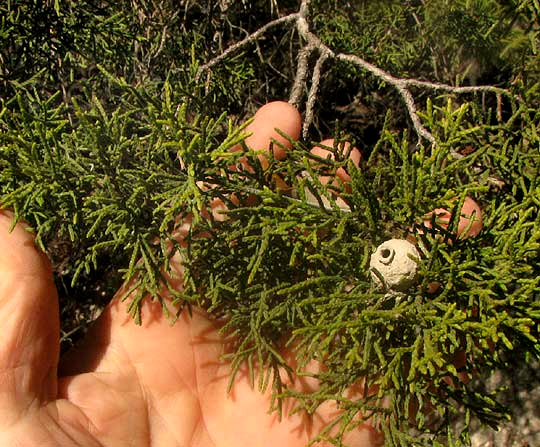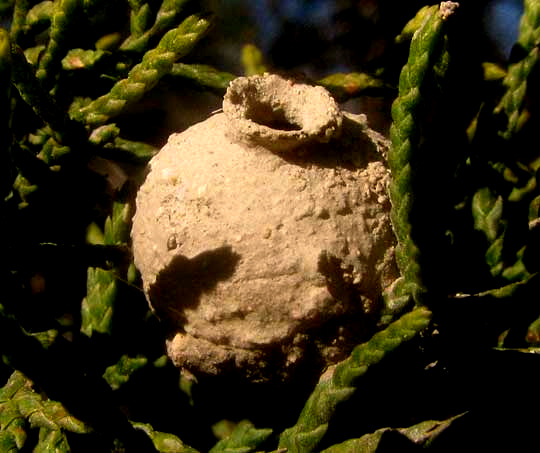Excerpts from Jim Conrad's
Naturalist Newsletter
from the February 2, 2014 Newsletter issued from the Frio Canyon Nature Education Center in the valley of the Dry Frio River in northern Uvalde County, southwestern Texas, on the southern border of the Edwards Plateau; elevation ~1750m (~5750 ft); N29.62°, W99.86°; USA
POTTER WASP POT
Beside the gravel road an Ashe Juniper branch at eye level bore among its branchlets the neat little dried-mud structure shown below:

A close-up better showing the structure below:

Even if you've never seen such a little mud urn perched on a tree branch like this, probably you can guess that it's the nest of a wasp, and that the wasp is closely related to the mud-daubers who build mud-tube nests beneath roof and cliff overhangs. This construction is much smaller and more elegant than those, however. It's the nest of a potter wasp, sometimes called mason wasp, Genus EUMENES, of which several species occur in southwestern Texas. Eumenes fraternus may be the most common and widespread here.
Like mud daubers, potter wasps are solitary -- don't form colonies. They sting many kinds of caterpillars, and sometimes beetle grubs, which paralyzes them, and then the prey is stored in a mud pot like that shown in our photo. The wasp then lays a single egg, attaching it to the pot's top inner surface. When the egg hatches, the larva feeds on the paralyzed, still living prey. The advantage of paralyzed prey over dead prey is that paralyzed prey doesn't decay. After the wasp larva pupates inside the pot the emerging adult breaks through the wall of the mud nest and escapes. Several generations can be produced per year.
Potter wasps are a little smaller than mud daubers, 3/8inch (2cm) to 3/4inch (3cm) long. The adult Eumenes fraternus is black with ivory markings on the abdomen and thorax, and feeds on flower nectar. Though potter wasps can sting if handled roughly, females don't defend their nests and aren't at all aggressive. In fact, for the service they provide of ridding gardens and fields of caterpillars, they're regarded as important and welcome citizens of the community, and never should be killed.
Our pot appeared to be empty, and there was no hole in its side where an adult had escaped. I wondered if it might be awaiting prey and an egg, maybe when warmer weather comes. Or maybe the pot had been so close to the road that a passing car disturbed the mother, causing her to abandon her work. It's known that mothers sometimes abandon their pots if disturbed while building them.